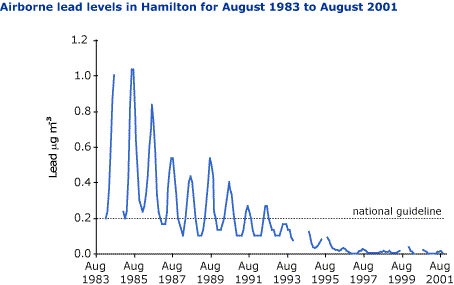Lead levels in air
What is lead?
Lead is a heavy metal that can affect people’s:
- nervous system – for example, causing headaches, disturbed sleep, depression, difficulty concentrating
- immune system – decreasing the body’s ability to fight infection
- blood pressure – causing it to increase.
Children are more at risk from lead poisoning than adults. Lead is dangerous to children because it can cause brain damage, affect their growth, and cause learning and behavioural problems. Young children can swallow harmful amounts of lead by eating, chewing or putting lead contaminated paint flakes or dust in their mouths.
In the mid-1980s steps were put in place by the New Zealand Government to reduce the amount of lead in fuels. Lead was later removed from fuels in 1996. This has eliminated a major source of lead in the environment.
Removal of lead-based paint from houses can still cause lead poisoning. Although it’s not used for exterior house paint in New Zealand anymore, lead-based paint can still be found on some older houses (especially those built before the late 1970s). Young children can swallow harmful amounts of lead by eating, chewing or putting lead-contaminated paint flakes or dust in their mouths. Pets are also susceptible to lead poisoning.
Another, localised source of lead in the environment is from old lead-based paint. Although it’s not used for exterior house paint in New Zealand anymore, lead-based paint can still be found on some older houses (especially those built before the late 1970s).
Lead from paint can enter the environment as:
- dust - for example, when old paint is being removed
- flakes - from old, deteriorating flaky paint.
Results - data and trends
Waikato Regional Council no longer monitors lead levels in air.
This indicator was last updated in June 2008.
Waikato Regional Council previously measured ambient air lead levels in Hamilton city, as it was suspected that high levels of traffic increased the risks from lead.
Lead was measured from 1983 to 2001, and results showed a large drop in the amount of lead in Hamilton’s air. From August 1993 to August 2001, lead levels were consistently below the Ministry for the Environment guideline value (0.2 µg/m3 as a three-monthly average), which indicated that lead is no longer of concern in Hamilton.
The removal of lead from fuels indicates that reductions in lead are similarly likely in all areas of the Waikato region.
The data file contains the source data for this indicator's information.




To ask for help or report a problem, contact us
Tell us how we can improve the information on this page. (optional)